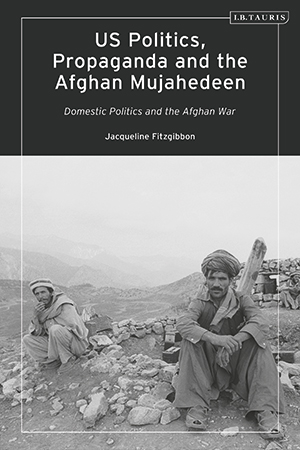US POLITICS, PROPAGANDA AND THE AFGHAN MUJAHEDEEN: domestic politics and the Afghan war
Published in Book Reviews, Book Reviews, Issue 6 (November/December 2020), Reviews, Volume 28JACQUELINE FITZGIBBON
I.B. Tauris
£76.50
ISBN 9781838604004
Reviewed by Angus Mitchell
Angus Mitchell is a historian and lives in Limerick.
 This study by Jacqueline Fitzgibbon extends from her Ph.D work at University College Cork. Well written and rigorously researched, it makes a considerable addition to the body of literature on American foreign policy. Furthermore, it provides important insight into how the intense battle for hearts and minds fought by the West during the 1980s led to the reduction of Afghanistan to a land of endless wars.
This study by Jacqueline Fitzgibbon extends from her Ph.D work at University College Cork. Well written and rigorously researched, it makes a considerable addition to the body of literature on American foreign policy. Furthermore, it provides important insight into how the intense battle for hearts and minds fought by the West during the 1980s led to the reduction of Afghanistan to a land of endless wars.
In the spring of 1978, the Saur revolution brought the People’s Democratic Party of Afghanistan to power. Sympathetic to Marxism-Leninism, the PDPA had strong connections with the Kremlin. The regime was both brutal and unstable, however, and over Christmas 1979 the Red Army crossed over the Oxus, fearful of destabilisation along its border. The West denounced the action as imperial expansionism. Over the next decade a low-intensity conflict was waged. Initially it was an asymmetric skirmish between badly armed mujahedeen jihadists fighting a modern army equipped with helicopter gunships and aerial bombers, but by 1986 the flow of sophisticated weaponry from the US, including anti-aircraft Stingers, saw the mujahedeen gradually advance and the morale of the Red Army break.
The conflict coincided with an era of growth in news media. Still recovering from the humiliation of Vietnam, the US saw the possibility of using the Soviet invasion as a way of avenging their own humiliation a decade earlier. The political right had often claimed that Vietnam was lost in the living rooms of America. Although President Jimmy Carter in his final years took a bullish stance over Afghanistan, it would be Ronald Reagan’s two terms in office that significantly ratcheted up tensions.
The Reagan Doctrine, bolstered by hard-line anti-communists and New Right/neo-conservative philosophies, led to the targeted support of counter-insurgency offensives in various countries, most notably Nicaragua, Cambodia, Mozambique and Angola. It was Afghanistan, however, that became the Cold War’s bloodiest battlefield. It attracted the most attention and has proved to be the most intractable conflict. Delivering ‘freedom’ to Afghanistan became a mantra that ran parallel to the gradual downfall of the Soviet Union.
Fitzgibbon explains how Washington policy was shaped by PVOs (Private Voluntary Organisations) and think-tanks such as the Heritage Foundation and the Committee for a Free Afghanistan that lobbied and influenced decision-makers. Covert operations, supported by US and British special forces, help to train mujahedeen. News teams and cameramen forged their reputations in perilous cross-border stunts. NGOs set up in Pakistan’s North West Frontier province were deployed to start funnelling money and arms through the refugee camps. Propaganda was used to legitimise the political credentials of the mujahedeen. Jihadist and merciless warlords became ‘freedom fighters’ seeking ‘self-determination’. The mujahedeen were represented as a coherent ‘democratic resistance’ upholding the legitimate voice of the Afghan people. The US alliance with the autocratic President Zia was downplayed as tens of millions of dollars were funnelled through Pakistan. A gulf opened between the complex reality of Afghan politics and the western construction of the war.
Tracing the lineage of propaganda back to the First World War, Fitzgibbon looks at the escalation of both bloodshed and media coverage. The most notorious intervention was made by the Texan Democrat Charlie Wilson (the subject of a Mike Nichols film starring Tom Hanks and Julia Roberts). In the background to all the spin and subterfuge lurks the spectre of the military-industrial complex. Fitzgibbon, however, recognises how the war assisted the US strategic ends of rearmament, including the replenishment of US chemical weapon stocks.
Though the Soviets tried to retreat from Afghanistan almost as soon as they had invaded, Washington did little to encourage peace because the war served broader strategic interests. Fitzgibbon might have provided a little more on Britain’s special relationship with the US: Margaret Thatcher took as determined a line on Afghan ‘freedom’ as Reagan and in 1981 made a visit to the Khyber Pass to declare her support. Fitzgibbon refers to figures in Britain such as Winston S. Churchill (grandson of his namesake), who was involved in organising Radio Free Kabul, but these scraps of information might have been elaborated on to build a more coherent understanding of the special relationship.
In February 1989, following the Geneva Accords, the Red Army retreated over the Oxus and left behind a ravaged country. It took another three years, however, before the PDPA’s President Najib finally fell, at which point Afghanistan descended into another cycle of violent chaos. One of the cruellest legacies was the desperate anti-personnel landmine problem that made resettlement perilous and continues to haunt civil society in Afghanistan to this day. The war had empowered local warlords, encouraged disregard for central authority and created the conditions for the emergence of al Qaeda after the Taliban came to power in 1996.
Fitzgibbon’s work provides mature and penetrating analysis and deserves a place in the modern library of Afghanistan, alongside Steve Coll’s Ghost wars and the work of Ahmed Rashid.
















